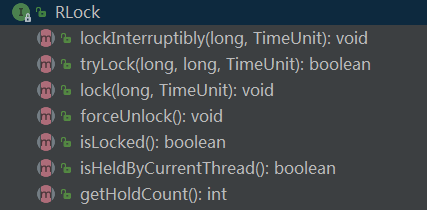转 Redission分布式锁源码解析
2332 | 0 | 0
Redission锁继承Implements Reentrant Lock,所以具备 Reentrant Lock 锁中的一些特性:超时,重试,可中断等。加上Redission中Redis具备分布式的特性,所以非常适合用来做Java中的分布式锁。 下面我们对其加锁、解锁过程中的源码细节进行一一分析。
锁的接口定义了一下方法:

分布式锁当中加锁,我们常用的加锁接口:
boolean tryLock(long waitTime, long leaseTime, TimeUnit unit) throws InterruptedException;
下面我们来看一下方法的具体实现:
public boolean tryLock(long waitTime, long leaseTime, TimeUnit unit) throws InterruptedException {
long time = unit.toMillis(waitTime);
long current = System.currentTimeMillis();
final long threadId = Thread.currentThread().getId();
Long ttl = tryAcquire(leaseTime, unit, threadId);
// lock acquired
if (ttl == null) {
return true;
}
time -= (System.currentTimeMillis() - current);
if (time <= 0) {
acquireFailed(threadId);
return false;
}
current = System.currentTimeMillis();
final RFuture subscribeFuture = subscribe(threadId);
if (!await(subscribeFuture, time, TimeUnit.MILLISECONDS)) {
if (!subscribeFuture.cancel(false)) {
subscribeFuture.addListener(new FutureListener() {
@Override
public void operationComplete(Future future) throws Exception {
if (subscribeFuture.isSuccess()) {
unsubscribe(subscribeFuture, threadId);
}
}
});
}
acquireFailed(threadId);
return false;
}
try {
time -= (System.currentTimeMillis() - current);
if (time <= 0) {
acquireFailed(threadId);
return false;
}
while (true) {
long currentTime = System.currentTimeMillis();
ttl = tryAcquire(leaseTime, unit, threadId);
// lock acquired
if (ttl == null) {
return true;
}
time -= (System.currentTimeMillis() - currentTime);
if (time = 0 && ttl < time) {
getEntry(threadId).getLatch().tryAcquire(ttl, TimeUnit.MILLISECONDS);
} else {
getEntry(threadId).getLatch().tryAcquire(time, TimeUnit.MILLISECONDS);
}
time -= (System.currentTimeMillis() - currentTime);
if (time <= 0) {
acquireFailed(threadId);
return false;
}
}
} finally {
unsubscribe(subscribeFuture, threadId);
}
// return get(tryLockAsync(waitTime, leaseTime, unit));
}首先我们看到调用tryAcquire尝试获取锁,在这里是否能获取到锁,是根据锁名称的过期时间TTL来判定的(TTL
下面我们接着看一下tryAcquire的实现:
private Long tryAcquire(long leaseTime, TimeUnit unit, long threadId) {
return get(tryAcquireAsync(leaseTime, unit, threadId));
}可以看到真正获取锁的操作经过一层get操作里面执行的,这里为何要这么操作,本人也不是太理解,如有理解错误,欢迎指正。
get 是由CommandAsyncExecutor(一个线程Executor)封装的一个Executor
设置一个单线程的同步控制器CountDownLatch,用于控制单个线程的中断信息。个人理解经过中间的这么一步:主要是为了支持线程可中断操作。
public V get(RFuture future) {
if (!future.isDone()) {
final CountDownLatch l = new CountDownLatch(1);
future.addListener(new FutureListener() {
@Override
public void operationComplete(Future future) throws Exception {
l.countDown();
}
});
boolean interrupted = false;
while (!future.isDone()) {
try {
l.await();
} catch (InterruptedException e) {
interrupted = true;
}
}
if (interrupted) {
Thread.currentThread().interrupt();
}
}
// commented out due to blocking issues up to 200 ms per minute for each thread:由于每个线程的阻塞问题,每分钟高达200毫秒
// future.awaitUninterruptibly();
if (future.isSuccess()) {
return future.getNow();
}
throw convertException(future);
}我们进一步往下看:
private RFuture tryAcquireAsync(long leaseTime, TimeUnit unit, final long threadId) {
if (leaseTime != -1) {
return tryLockInnerAsync(leaseTime, unit, threadId, RedisCommands.EVAL_LONG);
}
RFuture ttlRemainingFuture = tryLockInnerAsync(commandExecutor.getConnectionManager().getCfg().getLockWatchdogTimeout(), TimeUnit.MILLISECONDS, threadId, RedisCommands.EVAL_LONG);
ttlRemainingFuture.addListener(new FutureListener() {
@Override
public void operationComplete(Future future) throws Exception {
if (!future.isSuccess()) {
return;
}
Long ttlRemaining = future.getNow();
// lock acquired
if (ttlRemaining == null) {
scheduleExpirationRenewal(threadId);
}
}
});
return ttlRemainingFuture;
}首先判断锁是否有超时时间,有过期时间的话,会在后面获取锁的时候设置进去。没有过期时间的话,则会用默认的
private long lockWatchdogTimeout = 30 * 1000;
下面我们在进一步往下分析真正获取锁的操作:
RFuture tryLockInnerAsync(long leaseTime, TimeUnit unit, long threadId, RedisStrictCommand command) {
internalLockLeaseTime = unit.toMillis(leaseTime);
return commandExecutor.evalWriteAsync(getName(), LongCodec.INSTANCE, command,
"if (redis.call('exists', KEYS[1]) == 0) then " +
"redis.call('hset', KEYS[1], ARGV[2], 1); " +
"redis.call('pexpire', KEYS[1], ARGV[1]); " +
"return nil; " +
"end; " +
"if (redis.call('hexists', KEYS[1], ARGV[2]) == 1) then " +
"redis.call('hincrby', KEYS[1], ARGV[2], 1); " +
"redis.call('pexpire', KEYS[1], ARGV[1]); " +
"return nil; " +
"end; " +
"return redis.call('pttl', KEYS[1]);",
Collections.singletonList(getName()), internalLockLeaseTime, getLockName(threadId));
}我把里面的重点信息做了以下三点总结:
1:真正执行的是一段具有原子性的Lua脚本,并且最终也是由CommandAsynExecutor去执行。
2:锁真正持久化到Redis时,用的hash类型key field value
3:获取锁的三个参数:getName()是逻辑锁名称,例如:分布式锁要锁住的methodName+params;internalLockLeaseTime是毫秒单位的锁过期时间;getLockName则是锁对应的线程级别的名称,因为支持相同线程可重入,不同线程不可重入,所以这里的锁的生成方式是:UUID+":"threadId。有的同学可能会问,这样不是很缜密:不同的JVM可能会生成相同的threadId,所以Redission这里加了一个区分度很高的UUID;
Lua脚本中的执行分为以下三步:
1:exists检查redis中是否存在锁名称;如果不存在,则获取成功;同时把逻辑锁名称KEYS[1],线程级别的锁名称[ARGV[2],value=1,设置到redis。并设置逻辑锁名称的过期时间ARGV[2],返回;
2:如果检查到存在KEYS[1],[ARGV[2],则说明获取成功,此时会自增对应的value值,记录重入次数;并更新锁的过期时间
3:key不存,直接返回key的剩余过期时间(-2)
相关推荐:https://www.roncoo.com/course/list.html?courseName=redis
文章来源:https://my.oschina.net/u/2313177/blog/1919810
0

199****9888
7人已关注
-
 领课教育 32094
领课教育 32094 -
9910
-
 update 47181
update 47181 -
4981
-
 领课教育 18060
领课教育 18060 -
 husheng 20974
husheng 20974 -
 请更新代码 41632
请更新代码 41632 -
 凯哥Java 2235
凯哥Java 2235 -
 凯哥Java 2615
凯哥Java 2615 -
 凯哥Java 2004
凯哥Java 2004


 粤公网安备 44010602005928号
粤公网安备 44010602005928号